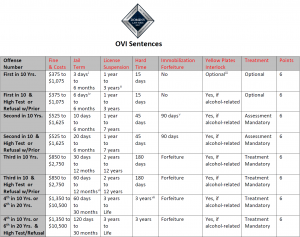 A recent article in Forbes Advisor purports to tell readers ‘everything you need to know’ about a first-offense DUI. The article discusses definitions, consequences, and options in general terms. It does not tell readers precise definitions, consequences, and options in a particular state. The problem is DUI laws are state-specific: every state has its own DUI laws. If you really want to know about a first-offense DUI in Ohio (where it’s called ‘OVI’), read on.
A recent article in Forbes Advisor purports to tell readers ‘everything you need to know’ about a first-offense DUI. The article discusses definitions, consequences, and options in general terms. It does not tell readers precise definitions, consequences, and options in a particular state. The problem is DUI laws are state-specific: every state has its own DUI laws. If you really want to know about a first-offense DUI in Ohio (where it’s called ‘OVI’), read on.
Definitions
For the purpose of sentencing in Ohio, the term ‘first offense’ means a first OVI within ten years.
In Ohio, there are two basic types of OVI (Operating a Vehicle under the Influence).
The first type is OVI ‘Impaired’. Ohio Revised Code section 4511.19(A)(1)(a) makes it illegal to operate a vehicle while ‘under the influence’ of alcohol and/or a drug of abuse. ‘Operate’ means to move or cause movement of a vehicle. ‘Under the influence’ means the alcohol and/or drug adversely affects and noticeably impairs a person’s actions, reactions, or mental processes so as to impair the person’s ability to operate the vehicle.
The second type is OVI ‘Per Se’. Ohio Revised Code section 4511.19(A)(1)(d)-(j) make it illegal to operate a vehicle with a prohibited concentration of alcohol and/or a drug of abuse. The prohibited concentrations for alcohol and specific drugs are listed in sub-paragraphs (d)-(j). For example, it is ‘per se’ illegal to operate a vehicle with a blood alcohol concentration of .080% or more.
If a driver tests ‘over the limit’, the driver may be charged with both OVI ‘Per Se’ and OVI ‘Impaired’.
Consequences
For a first-offense OVI in Ohio, there are mandatory minimum penalties and possible maximum penalties. There are three categories of mandatory penalties. First, there is a driver license suspension, which is a minimum of one year and a maximum of three years. Second, there is minimum jail term of three days and a maximum jail term of six months. Third, there is a mandatory fine which can range from a minimum of $375 to a maximum of $1,075.
In addition to the mandatory penalties, judges can impose optional sanctions. Those sanctions include a term of probation (aka ‘community control’), yellow license plates, an ignition interlock device, substance abuse counseling, and community service. When the license suspension is completed, the driver will be required to a pay a separate fee to the Ohio B.M.V. to have the driver license reinstated.
The OVI sentencing law is complex. There are nuances and exceptions to the summary above.
Options
Unlike some states, Ohio does not have diversion or deferred prosecution for OVI cases. Your options at the first court appearance are to plead guilty/no contest or not guilty. If you plead guilty to OVI, the judge or magistrate will impose the consequences described above, and the case will be finished. If you plead not guilty, the case will not be finished at the first court appearance. Instead, you will have additional court appearances and an opportunity to improve the outcome of the case.
Case outcomes can be improved. Our firm has found that, by pleading not guilty and effectively contesting the case, the OVI charge can be dismissed or to a lesser offense, and the penalties can be decreased. Whether it is worth the time and money to improve the outcome of the case is an individual decision.
State-Specific
The Forbes Advisor article was a well-written summary of first-offense DUI in general terms. However, if you are charged with DUI/OVI, you need to know the specific laws in the state where the case is being held. For first-offense OVI in Ohio, this article may not quite be ‘everything you need to know’, but it is specific to Ohio.
About the Author: Shawn Dominy is a leading OVI lawyer in Ohio and the founder of the Dominy Law Firm in Columbus, Ohio. He can be reached through his law firm’s website: Dominy Law Firm.